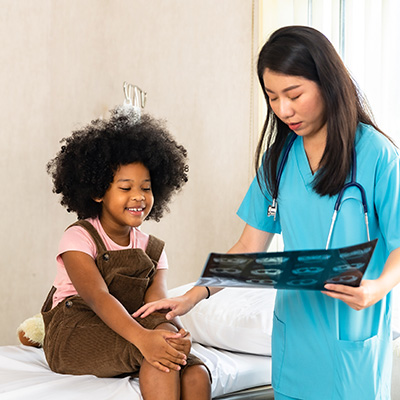Chest X-Ray in Children
What Is a Chest X-Ray?
A chest X-ray is a very common and quick test used to take pictures of the heart, lungs, bones, and soft tissues in the chest. It is a useful tool to help doctors diagnose or monitor respiratory and heart conditions.
The X-ray machine projects a small dose of radiation towards the chest. Some of this radiation passes through the body, while other parts are absorbed or deflected, depending on the tissue. This creates a detailed digital image that a specialist doctor (radiologist) can interpret.
How Does a Chest X-Ray Work?

To help understand the process, you can think of it like taking a photograph:
- Dense areas (like bones) block more radiation and appear white.
- Air-filled areas (like the lungs) let radiation pass through easily and appear black.
- Muscle, fluid, and fat appear in shades of grey, depending on their density.
The resulting image is recorded and viewed on a computer screen. A radiologist carefully examines the image and compares it to any previous scans to assess changes in the lungs, heart size, or blood flow patterns. The findings are then shared with your child’s doctor.
What Views Are Taken?
In young children, two images are usually taken:
- Front view (anterior-posterior) – your child may lie on a table with their hands held above their head.
- Side view (lateral) – depending on age and ability, this may be taken while lying down or standing.
In older children, the standard method is to stand upright for one image, then turn sideways for the second. A small light is used to position the machine and focus the radiation beam accurately, which helps limit exposure to the rest of the body.
Why Might My Child Need a Chest X-Ray?
A chest X-ray may be requested if your child has:
- Persistent coughing or wheezing
- Breathing difficulties or noisy breathing
- Chest infections or pneumonia
- Suspected inhaled or swallowed foreign objects
- Known or suspected lung or heart conditions (e.g., asthma, cystic fibrosis, congenital heart disease)
- Follow-up monitoring after illness, treatment or surgery
Is it Safe?
Yes. The amount of radiation used is very low and considered safe for children when medically indicated. The benefits of getting accurate diagnostic information far outweigh the small risk. All X-rays are done with child-safe practices in place to minimise exposure.
Preparing Your Child for a Chest X-Ray
There’s usually very little preparation required. However, it’s natural for children to feel anxious, especially around unfamiliar equipment. Here are some helpful tips:
- Explain to your child that the X-ray is just a quick picture of the chest and that it doesn’t hurt
- Parents are usually allowed to stay with their child during the X-ray and may be asked to wear a protective lead apron
- Encourage your child to stay as still as possible when the image is taken – this helps get a clear image and avoid repeat scans
- In very young children, gentle restraint may be used briefly to ensure the image is successful on the first try.
Our staff are experienced in working with children and will help ensure the test is quick, comfortable, and stress-free.
When Will We Get the Results?
The X-ray images are reviewed by a radiologist, who prepares a report. Your child’s doctor will discuss the results with you, at a follow-up appointment.
Safety of X-Rays
Radiation is a natural part of everyday life. It doesn’t only come from medical procedures—most of our exposure comes from natural sources:
- The sun, rocks and soil, and even the food and water we consume all emit small amounts of natural background radiation.
- For example, milk, vegetables, and drinking water all contain trace levels of radiation absorbed from the earth or the environment.
Medical X-rays account for around 15% of total annual radiation exposure. This includes both high-dose treatments (like radiotherapy) and low-dose imaging procedures like chest X-rays.
The amount of radiation from a chest X-ray is very small. Even when a child needs multiple X-rays or follow-up tests, the cumulative dose remains low.
Your child’s doctor will always ensure that the expected benefits of the test clearly outweigh any risk. The aim is to get the information needed to support safe and accurate diagnosis while keeping exposure to a minimum.
Located in London | Infants to young adults seen
Request a referral or book an appointment with Professor Gupta today.
